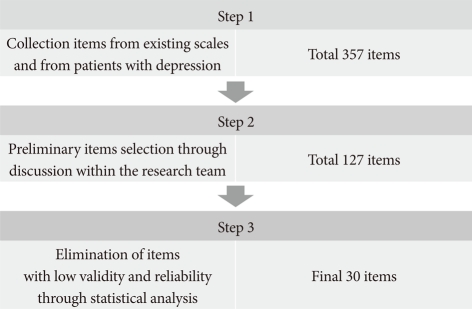1. Lee MS, Rhee MK. A development of Korea Depression Scale. J Korean Neuropsychiatr Assoc 2003;42:492-506.
2. Ohayon MM, Hong SC. Prevalence of major depressive disorder in the general population of South Korea. J Psychiatr Res 2006;40:30-36. PMID:
15878179.


3. Weissman MM, Bland RC, Canino GJ, Faravelli C, Greenwald S, Hwu HG, et al. Cross-national epidemiology of major depression and bipolar disorder. JAMA 1996;276:293-299. PMID:
8656541.


4. Ustun T, Sartorius N. Mental Illness in General Health Care: An International Study. 1995,New York: John Wiley and Sons.
5. Kim TS, Jeong SH, Kim JB, Lee MS, Kim JM, Yim HW, et al. The clinical research center for depression study: baseline characteristics of a Korean long-term hospital-based observational and collaborative prospective cohort study. Psychiatry Investig 2011;8:1-8.


6. Park EHM, Dimigen G. A cross-cultural comparison: postnatal depression in Korean and Scottish mothers. Psychologia 1995;38:199-207.
7. Yoshida K, Marks MN, Kibe N, Kumar R, Nakano H, Tashiro N. Postnatal depression in Japanese women who have given birth in England. J Affect Disord 1997;43:69-77. PMID:
9127832.


8. Lee D, Yip A, Chiu H, Leung T, Chung T. A psychiatric epidemiological study of postpartum Chinese women. Am J Psychiatry 2001;158:220-226. PMID:
11156804.


9. Kim JY, Cho SM, Seo GH, Cho SJ, Kim JK, Cho MJ. Trans-cultural difference in expressing depressive symptoms in Koreans-Factor structure of the Center for Epidemiologic Studies Depression Scale (CES-D). Korean J Psychopathol 2000;9:78-87.
10. Cho MJ, Kim KH. Diagnostic validity of the CES-D(Korean version) in the assessment of DSM-III-R major depression. J Korean Neuropsychiatr Assoc 1993;32:381-399.
11. Beck AT. The Beck Depression Inventory. 1978,Philadelphia: Center for Cognitive Therapy.
13. Okano T, Nomura J, Kumar R, Kaneko E, Tamaki R, Hanafusa I, et al. An epidemiological and clinical investigation of postpartum psychiatric illness in Japanese mothers. J Affect Disord 1998;48:233-240. PMID:
9543214.


14. Ghubash R, Abou-saleh MT. Postpartum psychiatric illness in Arab culture: prevalence and psychosocial correlates. Br J Psychiatry 1997;171:65-68. PMID:
9328498.


15. Zung WWK. A self-rating depression scale. Arch Gen Psychiatry 1965;12:63-70. PMID:
14221692.


16. Cho MJ, Bae JN, Suh GH, Hahm BJ, Kim JK, Lee DW, et al. Validation of Geriatric Depression Scale, Korean Version (GDS) in the assessment of DSM-III-R major depression. J Korean Neuropsychiatr Assoc 1999;38:48-63.
17. Hamilton M. A rating scale for depression. J Neurol Neurosurg Psychiatry 1960;23:56-62. PMID:
14399272.



18. Carroll BJ, Feinberg M, Smouse PE, Rawson SG, Greden JF. The Carroll rating scale for depression. I. Development, reliability and validation. Br J Psychiatry 1981;138:194-200. PMID:
7272609.


19. Montgomery SA, Asberg M. A new depression scale designed to be sensitive to change. Br J Psychiatry 1979;134:382-389. PMID:
444788.


20. Birleson P. The validity of depressive disorder in childhood and the development of a self-rating scale: a research report. J Child Psychol Psychiatry 1981;22:73-88. PMID:
7451588.


21. Butcher JN, Dahlstrom WG, Graham JR, Tellegen A, Kaemmer B. Minnesota Multiphasic Personality Inventory-2 (MMPI-2): Manual for Administration and Scoring. 1989,Minneapolis, MN: University of Minnesota Press.
22. Blatt SJ, D'Afflitti JP, Quinlan DM. Depressive Experiences Questionnaire. 1976,New Haven: Yale University Press.
23. Beck AT, Weissman A, Lester D, Trexler L. The measurement of pessimism: the hopelessness scale. J Consult Clin Psychol 1974;42:861-865. PMID:
4436473.



24. Holsti OR. Content Analysis for the Social Sciences and Humanities. 1969,Reading, MA: Addison-Wesley.
25. First MB, Spitzer RL, Gibbon M, Williams JBW. Structured Clinical Interview for DSM-IV Axis I Disorders. 1995,Washington, DC: American Psychiatric Association.
26. Kim Z, Han K, Lim J, Lee J, Min B, Moon K, et al. The MMPI-2; Minnesota Multiphasic Personality Inventory (User Manual). 2005,Seoul, Korea: Maumsarang Inc.
27. Obuchowski NA, McClish DK. Sample size determination for diagnostic accuracy s tudies involving binormal ROC curve indices. Stat Med 1997;16:1529-1542. PMID:
9249923.


28. Kaiser HF. An index of factorial simplicity. Psychometrika 1974;39:31-36.

29. Bentler PM, Bonnett DG. Significance tests and goodness-of-fit in the analysis of covariance structures. Psychol Bull 1980;88:588-606.

30. Byrne BM. Structural Equation Modeling with EQS and EQS/Windows. 1994,Thousand Oaks, CA: Sage.
31. Hoyle RH, Panter AT. In: Hoyle RHWriting about Structural Equation Models. , editor. Structural Equation Modeling: Concepts, Issues and Applications. 1995,Thousand Oaks, CA: Sage, p. 76-99.
32. Browne MW, Cudeck R. In: Bollen KA, Long JSAlternative Ways of Assessing Model Fit. , editor. Testing Structural Equation Models. 1993,Newbury Park, CA: Sage, p. 136-162.

33. MacCallum RB, Browne MW, Sugawara HM. Power analysis and determination of sample size for covariance structure modeling. Psychol Methods 1996;1:130-149.

34. Bentler PM. Comparative fit indexes in structural models. Psychol Bull 1990;107:238-246. PMID:
2320703.



35. Lewinsohn PM, Teri L. Selection of depressed and nondepressed subjects on the basis of self-report data. J Consult Clin Psychol 1982;50:590-591. PMID:
7119243.



36. Lee YH, Song JY. A study of the reliability and the validity of BDI, SDS, and MMPI-D scales. Korean J Clin Psychol 1991;10:98-113.





